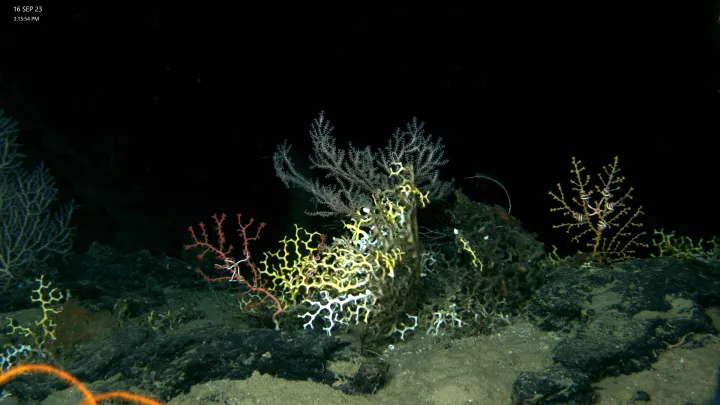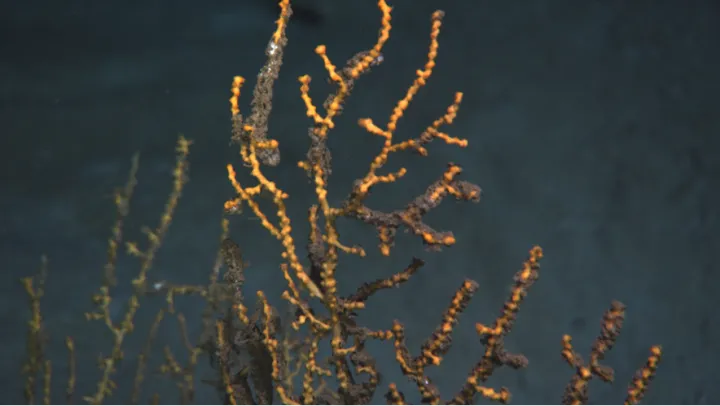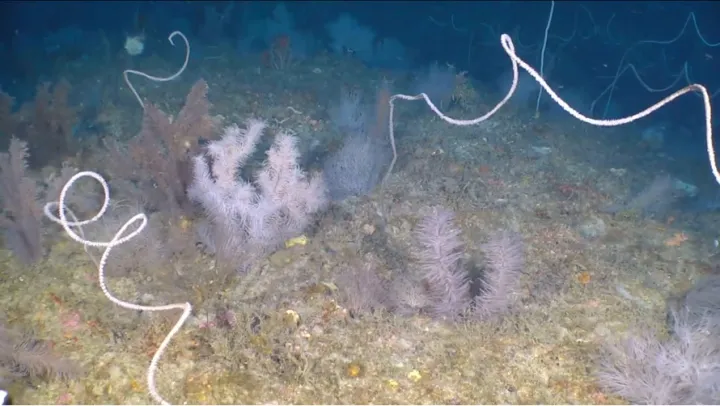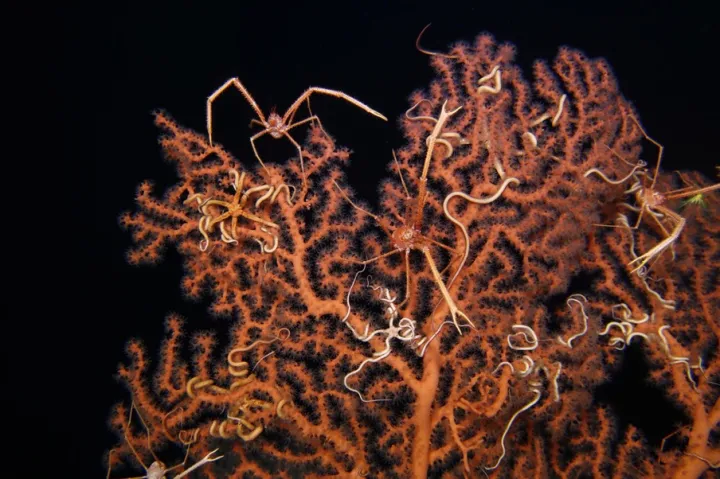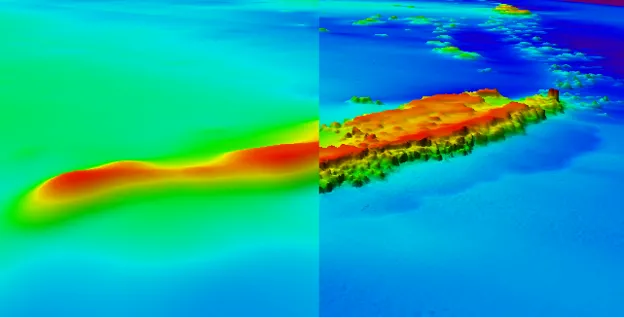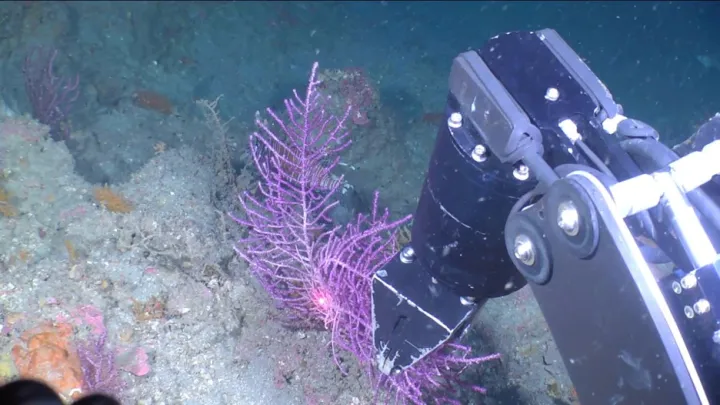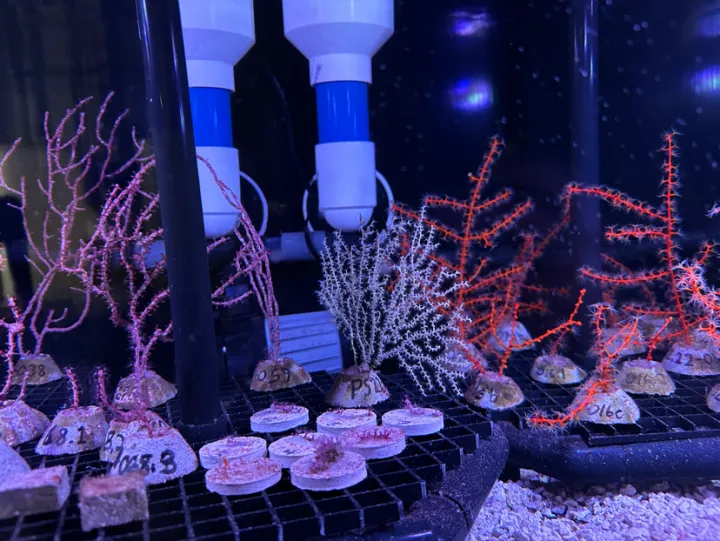Deep Gulf Restoration After a Monumental Oil Spill
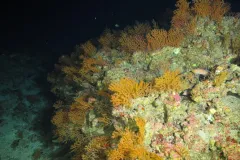
On April 20th 2010 the BP Macondo wellhead, located 47 miles off the coast of Louisiana, blew out, resulting in the largest offshore oil spill in US history. For 87 days, oil spewed from the wellhead resulting in an oil slick that covered an area the size of Virginia. Carried by ocean currents, wind, and waves, oil traveled to shore, eventually contaminating 1,300 miles of coastline from Texas to Florida. Every ecosystem in the Gulf from Texas to Florida was impacted by the spread of crude oil. Oil washed into salt marshes where it coated the marsh grasses and blocked sunlight from reaching the leaves. It formed tar balls that washed onto beaches and became a nuisance for any beachgoers in the Gulf states. Oil even reached the seafloor where it blanketed corals deep below the ocean surface.
The muddy seafloor may seem inhospitable to life, but scattered across the silty bottom there are underwater islands of hard rock. On these havens of sturdy substrate are complex and diverse habitats that support the ocean's food web. These seafloor, or “benthic,” communities can be found in the Gulf’s “mesophotic zone” at depths between 160 feet (50 meters) and 1,000 feet (300 meters) and in the deep sea at depths below 1,000 feet (300 meters). In the mesophotic zone, only a little bit of sunlight is able to reach those depths, and in the deep sea there is no sunlight at all.
Damage to the Deep
Despite being located at depths that are hard to reach, these diverse communities can still be injured by human activity. In the wake of the spill, oil reached the seafloor in two ways. The damaged wellhead was located almost 5,000 feet below the surface of the ocean and much of the oil that spilled never made it out of the deep sea. Then some of the oil that did float to the sea surface mixed with plant and animal material and sank back down to the benthos as contaminated marine snow. In total over 770 square miles of mesophotic and deep-sea habitats were impacted by the oil spill.
Deep-water corals were smothered by the toxic contaminants released during the oil spill. As marine scientists were surveying the seafloor near the wellhead using a remotely operated vehicle (ROV) they came across corals covered in a strange dark brown substance called “floc” (this is short for the word “flocculent,” which described its loosely clumped texture). After sampling the substance they were able to trace chemicals in the floc back to the oil from the wellhead. Corals that had been coated in the floc eventually lost branches, became covered in hydroids, or died in the years following the spill.
Most of the mesophotic and deep water corals that were injured by the spill were corals that belong to the recently reorganized Class of corals, Octocorallia. Octocorals are the foundation of these communities and account for over half of the deep-sea coral species. They get their name from the eight tentacles that surround the central mouth of each individual animal, which is called a polyp. The polyps grow in colonies and those colonies come in just about every shape imaginable. Some, like Ellisella elongata look like long strings sticking up out of the habitat. Others called sea pens, look like feather quills sitting on the seafloor and swaying in the ocean current. Many are highly branched and resemble leafless bushes sitting against the dark backdrop of the deep seafloor.
Like trees in a forest, corals provide the structure that many other animals live on and around in mesophotic and deep seafloor communities. Other invertebrates like basket stars, crinoids (sea lilies and feather stars), and brittle stars will settle and grow on top of established corals to elevate themselves off the seafloor. Crustaceans like squat lobsters, arrow crabs, and deep-sea shrimp take shelter amongst the branches of the coral, snapping food from the passing ocean currents. Higher up the food chain, schools of fish and squads of squid hunt around the habitat that the corals provide. When the corals die off, as they did following the oil spill, there is a ripple effect in the ecosystem that touches upon all the life in it.
Restoration Efforts
After years of assessing the damage to different ecosystems impacted by the oil spill, an historic 8.8 billion dollar settlement was reached to help restore injured habitats and resources. Part of the settlement included funds to restore the mesophotic and deep seafloor communities. However, these habitats are difficult and expensive to access, so there is a lot that remains unknown about them and about how to restore them.
In order to successfully restore injured mesophotic and deep seafloor communities, several questions need to be answered. These questions include where exactly these communities are, what they look like, and how similarly they look and function across the Gulf. Are there ways that we can help corals grow and reproduce? Can we reduce the threats these deep habitats face? Projects to help answer these questions and to restore mesophotic and deep benthic communities were selected in 2019 by a group of federal agencies that serve as trustees for natural resources on behalf of the public. The Mesophotic and Deep Benthic Communities projects (MBDC projects) are led by the National Oceanic and Atmospheric Administration (NOAA) in partnership with the Department of the Interior.
It would not be possible to restore injured habitats without knowing where they are or to what extent they were injured. Highly detailed maps of the seafloor are needed to detect suitable habitats for deep coral communities, however, less than 1 percent of the Gulf has been mapped at high resolutions of 1 meter or less. Satellite technologies cannot penetrate the ocean well, so for the MDBC mapping project NOAA uses research vessels equipped with multibeam sonar and other technologies to map the seafloor. The MDBC mapping team has created some of the most detailed maps of the northern Gulf ever produced using these technologies. Using the data obtained through sonar, the mapping team has begun to learn more about where deepwater corals are likely to grow.
After identifying the areas on the seafloor where these coral communities exist, scientists have to determine what healthy mesophotic coral or deep seafloor coral communities look like. Previous research has given scientists a rough idea of the coral species and the associated organisms that make up these communities, however there are still many deep-sea coral communities that humans have never seen. These unknown communities could contain new species, or new groups of species that haven’t been documented. Since these communities are too deep in the ocean for people to visit or work in regularly in person, scientists rely on technologies like remotely operated vehicles (ROVs) and environmental DNA (eDNA) to study communities at greater depths.
Restoration of mesophotic and deep seafloor communities is also taking place by helping to stimulate new growth and reproduction of coral species that were most injured by the oil spill. Twelve species of octocorals were identified as priorities for restoration because of how important they are to other species in the Gulf and because they were the most impacted by the spill. So far, federal labs in Texas, South Carolina, and Florida have been able to grow three of those species- Swiftia exserta, Muricea pendula, and Thesea nivea - in special aquariums. By keeping these corals in aquariums, scientists are learning how these key species grow and reproduce. An important part of this work includes testing the kinds of surfaces, or “artificial substrates,” where new coral larvae or fragments might prefer to settle and grow. Artificial substrates are materials that wouldn’t normally be found in a particular habitat but can provide stable surfaces for new growth. Scientists hope to use what they learn to transplant coral fragments back into the Gulf and enhance the growth of key coral species on artificial substrates to help replace those injured by the spill.
The MDBC restoration projects are the first attempts at restoration of deep seafloor communities in the Gulf and they have already made great strides towards success. In 2022, the first of 5 years of planned restoration cruises was completed. Across 8 cruises, NOAA and over 20 collaborators mapped 2,185 square miles of seafloor, documented key mesophotic coral spawning events, and completed 107 ROV dives to better characterize and understand these habitats. There is still a lot to learn about these remote habitats, but with ongoing projects like the MDBC restoration projects, scientists are making new discoveries about these vital seafloor habitats and learning how to protect them from future threats like the Deepwater Horizon oil spill.
At the Smithsonian
The Smithsonian’s National Museum of Natural History is one of the many partners helping make this restoration work possible. Many of the specimens that are collected on restoration expeditions are sent back to the museum where experts like Curator of Corals, Andrea Quattrini, and Curator of Crustaceans, Martha Nizinski, in the Invertebrate Zoology department identify all the coral, crustacean, sea stars, and other invertebrate species. Those specimens will then be added to the museum’s Invertebrate Zoology collection so that they can be used as a reference and in future science. The museum’s vast collection is also being used to look back at corals and other invertebrates collected in the Gulf from before the spill to better understand the diversity of life in the Gulf through time.


